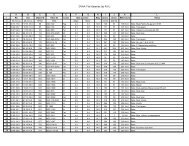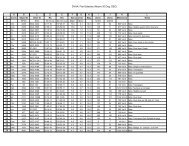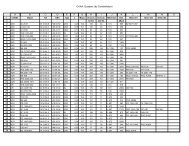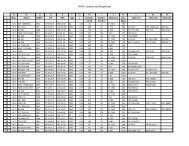Palomar Globular Clusters - The Delaware Valley Amateur ...
Palomar Globular Clusters - The Delaware Valley Amateur ...
Palomar Globular Clusters - The Delaware Valley Amateur ...
You also want an ePaper? Increase the reach of your titles
YUMPU automatically turns print PDFs into web optimized ePapers that Google loves.
SEVENTH H AVfN I TIDAl TAlE I lY APN I A' OM nc <br />
THE QUARTERLY JOURNAL OF<br />
UK ISSN 0967-6139
AI Lamperti<br />
<strong>Globular</strong> clusters are some ofthe oldest deep-sky<br />
objects, having formed during a galaxy's final<br />
condensation. As a result, they are also quite a<br />
distance from the center of the galaxy and are<br />
often found in the galaxy's halo. Many globular<br />
clusters can be seen in the Milky Way and even<br />
the globular clusters in our nearby neighboring<br />
galaxies are wi thin the reach of amateur<br />
telescopes.<br />
<strong>The</strong> <strong>Palomar</strong> globular clusters were found on<br />
the plates ofthe <strong>Palomar</strong> Observatory Sky Survey<br />
taken with the 48-inch Schmidt telescope in<br />
1950s. <strong>The</strong>re are 15 clusters on the list. David<br />
Ratledge wrote a comprehensive history with<br />
images of each of the globular clusters.!<br />
Many observers have reported their findings,<br />
e.g. Barbara Wilson. 2 However, a search of <strong>The</strong><br />
Deep-Sky Observer Index only found two articles<br />
on <strong>Palomar</strong> 2 by Maurice Gavin 3 and Steve<br />
Gottlieb 4 Recently, an observing buddy of the<br />
author,Joe McCormick from the <strong>Delaware</strong> <strong>Valley</strong><br />
<strong>Amateur</strong> Astronomers, asked if I had ever seen<br />
any of the <strong>Palomar</strong> clusters. A quick review of<br />
an electronic database indicated all were seen,<br />
some twice, save for two. Those two were<br />
immediately added to the list for the next<br />
observing session. <strong>The</strong> following descriptions<br />
were made by the author with 13-inch, 18-inch<br />
and 20-inch f/5 Dobsonian reflectors from dark<br />
sky sites in Pennsylvania, w ith one made in<br />
Weston, Vermont.<br />
<strong>Palomar</strong> 1<br />
20-inch f/5, 272x<br />
To find it, I needed the<br />
Millennium Star Atlas to<br />
star-hop. <strong>The</strong> cluster was<br />
seen with direct vision<br />
under a triangular asterism.<br />
<strong>The</strong>re may have been<br />
some resolution as a<br />
couple of stars were<br />
discernible. Estimated<br />
<strong>Globular</strong> Class XI (actually<br />
XII).<br />
<strong>Palomar</strong> 2<br />
20-inch f/5, 272x<br />
This was observed on the<br />
same night as <strong>Palomar</strong> 1.<br />
<strong>The</strong> Millennium Atlas<br />
helped. It makes an<br />
equilateral triangle with two<br />
stars, with <strong>Palomar</strong> 2 at the<br />
apex. It is a hazy patch<br />
and not quite resolvable.<br />
Ie<br />
f<br />
l<br />
5<br />
T<br />
a<br />
a<br />
9<br />
22
<strong>Palomar</strong> 3 (left) <br />
18-inch f/5.17, 177x & 256x <br />
This was a very small, very <br />
faint globular cluster and <br />
not resolvable. <br />
Seven years later: 20-inch f/ <br />
5,272x. <br />
I needed the Millennium <br />
Atlas to find it. <br />
It is small with no <br />
resolution, like a round <br />
galaxy. <br />
<strong>Palomar</strong> 4 (right) <br />
20-inch f/5, 272x <br />
It is located on the border <br />
of Coma Berenices and <br />
Ursa Major. This was a <br />
hard one; very faint, like an <br />
out-of-focus star. <br />
<strong>Palomar</strong> 5 (left)<br />
18-inch f/5.17, 256x<br />
Looks like a faint galaxy<br />
with no resolution.<br />
Seven years later: 20-inch f/<br />
5, 272x.<br />
This was difficult to see<br />
and needed averted vision<br />
(scale 3) . Also I needed<br />
jiggling of the telescope<br />
and a cover over my head.<br />
It was a very faint hazy even<br />
glow in the area indicated<br />
by the atlas.<br />
No resolution seen.<br />
<strong>Palomar</strong> 6 (right)<br />
20-inch f/5, 272x<br />
This one needed an averted<br />
vision scale #2. It was a<br />
hazy, faint glow with no<br />
resolution seen.<br />
<strong>Palomar</strong> 7 (IC 1276) (left)<br />
20-inch f/5, 313x<br />
I could only make out a<br />
handful of stars: 3 bright<br />
ones and a couple of dim<br />
ones. <strong>The</strong>re are probably<br />
more that are fainter.<br />
<strong>Palomar</strong> 8 (right)<br />
18-inch f/5.17, 286x<br />
It looks like a faint galaxy.<br />
Eleven years later: 20-inch<br />
f/5, 313x. I would have<br />
missed it except the image<br />
showed the star field. It is<br />
small, like a minuscule<br />
open cluster.<br />
23
<strong>Palomar</strong> 9 (NGC 6717) (left)<br />
13.1-inch f/5.17, 70x & 240x<br />
This globular cluster is a<br />
Herschel object (111-143)<br />
and was fairly bright and<br />
just about resolvable. It<br />
reminded me of a galaxy.<br />
<strong>Palomar</strong> 10 (right)<br />
13.1-inch f/4.5, 130x<br />
Averted vision and shaking<br />
of the telescope slightly<br />
showed a small, faint,<br />
round glow with no<br />
resolution.<br />
Nine years later: 20-inch f/5,<br />
313x. This time it was seen<br />
with direct vision but it still<br />
appeared as a round glow<br />
with no definition.<br />
<strong>Palomar</strong> 11 (left)<br />
20" f/5, 272x<br />
A bright star on the edge of<br />
the globular as seen in<br />
Uranometria was a clue.<br />
With that star off the edge<br />
of the field, a grouping of<br />
stars seems like an open<br />
cluster. Estimated <strong>Globular</strong><br />
Class XII (Really = XI) . .<br />
<strong>Palomar</strong> 12 (right)<br />
20" f/5, 313x<br />
This was easy to find<br />
adjacent to a small<br />
asterism triangle of 3 stars.<br />
It appeared as a fainter<br />
glow adjacent to the<br />
asterism. Only a handful<br />
of stars were discernible.<br />
<strong>Palomar</strong> 13 (left)<br />
20" f/5, 272x<br />
<strong>The</strong> Millennium Atlas was<br />
helpful to decipher the<br />
fainter stars in an asterism.<br />
<strong>The</strong> globular was seen with<br />
averted vision (scale 1) as<br />
a hazy glow with no .<br />
resolution.<br />
<strong>Palomar</strong> 14 (right)<br />
20" f/5, 272x & 416x<br />
This was a tough one. At<br />
best it was an averted<br />
vision (scale 3) . I saw it<br />
fleetingly twice, once urider<br />
416x. It was found in an<br />
area indicated by<br />
Uranometria.<br />
24
<strong>Palomar</strong> 15<br />
20" f/5, 272x<br />
This appeared as a milky<br />
area seen with an averted<br />
vision (scale 2).<br />
Photographs confirm<br />
ocation.<br />
Although the <strong>Palomar</strong> globular clusters are an ideal<br />
observing challenge, o ne may w ish to push the<br />
envelope a bit further by observing a list of extreme<br />
h alo clusters. <strong>The</strong>se are all at least 70 kiloparsecs<br />
(228,000 li ght years) fro m the Sun and include<br />
som e of the Palo m ar clusters. Barbara Wilson<br />
again has demonstrated her knowledge and skills<br />
in her descriptio ns of theseS<br />
References<br />
[1] http://w ww.dee p-s ky.co. u k/ o bserv ingl<br />
palglobs/ palglobs. htm<br />
[2] http: // a s t r o n 0 m y - m a I I . c o m I<br />
Ad ve ntur es. In,D ee p . Sp a c e l<br />
palglo b.htm#tips<br />
[3] 'G lobular Star Cluster <strong>Palomar</strong> 2', Maurice<br />
G av in WSQJ 88: 48 April1992<br />
[4] <strong>The</strong> Visibility of<strong>Palomar</strong> 2', Steve Gottlieb,<br />
WSQJ 90: 44, O ctober 1992<br />
[5] http :// a s t r o n 0 m y - m a II . c o m I<br />
Adventures.In.Deep,Space/obscure2.htm<br />
No. Const.<br />
1 C ep<br />
2 Aur<br />
3 Sex<br />
4 UMa<br />
5 Ser<br />
6 Oph<br />
7 Ser<br />
8 Sgr<br />
9 Sgr<br />
10 Sge<br />
11 Aql<br />
12 Cap<br />
13 Peg<br />
14 Her<br />
15 Oph<br />
<strong>The</strong> <strong>Palomar</strong> <strong>Globular</strong> <strong>Clusters</strong><br />
RA Dec. Mag. Size Class 1 Distance l<br />
033320.6 +793456 13.6 1.8' XlI 150<br />
044605.8 +312255 13.0 1.9' IX 114<br />
100530.9 +000415 13.9 2.8' XlI 313<br />
112915.8 +285823 14.2 2.1' Xl1 304<br />
151605.3 -000641 11.8 6.9' XlI 70<br />
174342.2 -2613 21 11.6 7.2' Xl 10<br />
181045.7 -071242 10.3 7.1' XII 42<br />
184129.9 -194933 11.2 4.7' X 1<br />
18 5506.2 -224203 9.2 3.9' VIII 52<br />
191802.0 +183422 13.2 3.5' XlI 2J<br />
194514.4 -080026 9.8 3.2' Xl 36<br />
214638.9<br />
230644.5<br />
-211510<br />
+124619<br />
11.7<br />
14.5<br />
2.9'<br />
1.8'<br />
XlI<br />
XlI<br />
1610 59 +145730 14.7 2.1' XlI 2+J.<br />
165951.1 -003200 14.2 11')..-9' XlI .L<br />
62<br />
-",<br />
Data obtained from Deep Sky Browser (http://www.messier45.com)<br />
I<br />
Hogg, Helen Battles Sawyer, 'Harlow Shapley and <strong>Globular</strong> <strong>Clusters</strong>'. PIlb/i,a/it'lL; . ~f ,"e<br />
Astrollomical Society ofthePacific 77 (458): 336-46, 1965. (Basically; Class I is giH'U [Q he c1u_ rers<br />
with the highest concentration and XII to the clusters with the lowest concenrrari n.<br />
2 X lO'lJight years<br />
25









